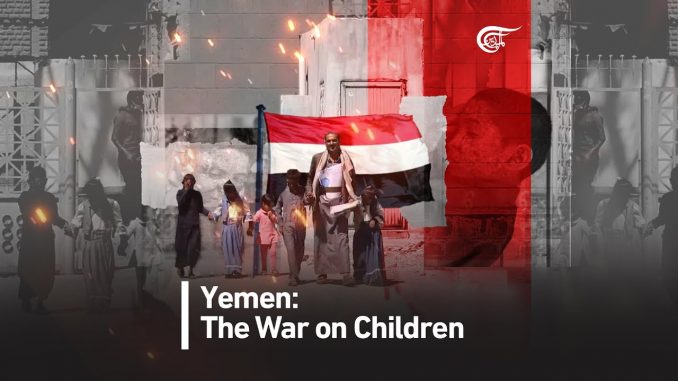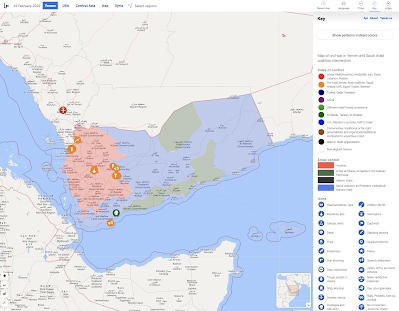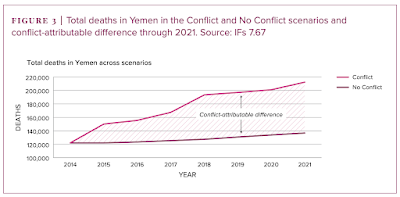
One war in the world is now in its seventh year but you would never know it unless you happen to get your news from a non-mainstream source.
Here is some background from the Council on Foreign Relations and the Brookings Institution regarding this ongoing conflict which involves one of the world's most underdeveloped nations and one of Washington's best friends in the Middle East (with my bold):
"Yemen’s civil war began in 2014 when Houthi insurgents—Shiite rebels with links to Iran and a history of rising up against the Sunni government—took control of Yemen’s capital and largest city, Sana’a, demanding lower fuel prices and a new government. Following failed negotiations, the rebels seized the presidential palace in January 2015, leading President Abd Rabbu Mansour Hadi and his government to resign. Beginning in March 2015, a coalition of Gulf states led by Saudi Arabia launched a campaign of economic isolation and air strikes against the Houthi insurgents, with U.S. logistical and intelligence support.
The Saudis intervened in March 2015 to support Hadi. The main driver behind the intervention was Prince Mohammed bin Salman (MBS) who promised a short, decisive war. Instead it became a stalemate with catastrophic consequences for the Yemeni people. The Saudis blockaded the country, denying food and medicine to most of the population.
President Barack Obama backed the Saudi war. The United States supported the passage of United Nations Security Council Resolution 2216, which sanctions the Houthis and Saleh, endorses Hadi’s government, and calls for the rebels to disarm. It’s completely unbalanced and a barrier to getting peace. Iran supports the Houthis with expertise, arms, and ballistic missiles smuggled into the country. The United States provides intelligence and crucial logistical support for the Saudis and their allies.
President Trump doubled down on Obama’s support for MBS’s war. The administration has focused on Iran’s support for the Houthis and ignored egregious Saudi bombings of school and hospitals. The Saudis’ war is very expensive for the kingdom, disastrously devastating for Yemen, and a strategic plus for Iran.
Saudi oil wealth explains much about why America has consistently subsumed its Yemen policy to the designs of the kingdom."
According to the Brookings Institution, the war in Yemen costs the Saudis at least $50 billion annually. It is also important to remember that the United States has sold significant arms to the Saudi royal family, arms that are being used against Yemeni civilians. Under the Trump administration, Washington signed arms deal in May 2017 as shown here:
…and the Biden Administration as shown here:
…along with diplomatically backing Saudi Arabia as shown here:
As background, here is a current map showing the situation on the ground in Yemen showing that Saudi Arabia controls a substantial portion of the nation:
Now, let's look at the impact of Washington's relationship with Saudi Arabia, particularly the impact of the Saudi royal family's war on Yemen's civilians. According to a recent report from the United Nations:
…the conflict has resulted in significantly higher deaths than would normally have been expected as shown on this graphic which compares the conflict and no-conflict scenarios (page 32 of the report):
It has also resulted in a significant loss of economic output as shown here (page 33 of the report):
The conflict has also resulted in significant damage to over one-third of Yemen's schools, 40 percent of health facilities, 40 percent of housing assets, 40 percent of water, sanitation and hygiene assets and over half to he nation's power infrastructure. The estimated cost to recover the lost infrastructure is estimated at between $20 billion and $25 billion over a five year period.
Here is a table showing the contrast between the conflict and no-conflict scenarios (page 33 of the report):
Entesaf Organization for Women and Child Rights has recently released a report with the following information:
1.) approximately 800,000 women are among Yemenis displaced by the war.
2.) between the start of aggression on March 26, 2015 to December 8, 2021, 2412 women were killed and 2825 were injured as a result of Saudi-led raids.
3.) 1.2 milion Yemeni women suffer from malnutrition with 8000 dying annually due to the blockade. Of the displaced women, half are pregnant and more than 70 percent of birth medicines are not available in Yemen due to the Saudi-led blockade of all sea, land and air borders since November 2017. In addition, out of every 1000 live births, more than 27 die annually.
4.) More than 400,000 Yemeni children are suffering from severe malnutrition with 80,000 of those at risk for death.
Here is a video explaining the plight of Yemen's children:
In large part, the blame for this suffering of Yemen's civilians must be laid at the feet of the decision makers from both parties in Washington who repeatedly find themselves siding with Saudi Arabia, a nation well known for its human rights abuses. While this sort of behaviour is frequently used by Washington to justify military intervention, such is not the case with Saudi Arabia simply because the Saudi royal family controls the world's most productive oil fields.
You can publish this article on your website as long as you provide a link back to this page.









Be the first to comment